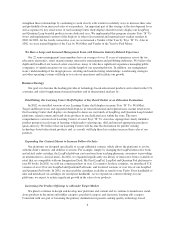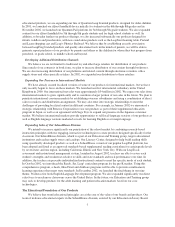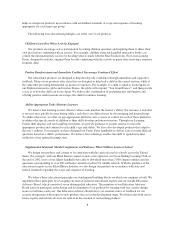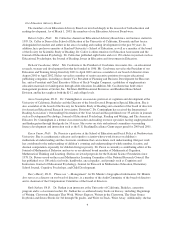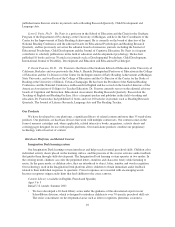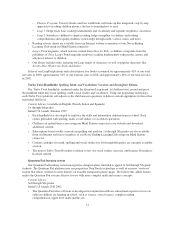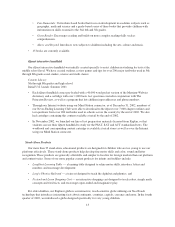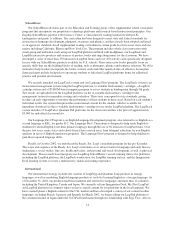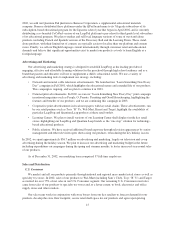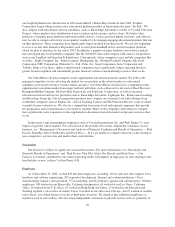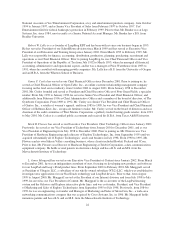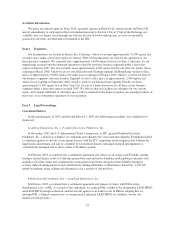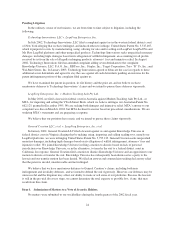LeapFrog 2002 Annual Report Download - page 21
Download and view the complete annual report
Please find page 21 of the 2002 LeapFrog annual report below. You can navigate through the pages in the report by either clicking on the pages listed below, or by using the keyword search tool below to find specific information within the annual report.components, including cooperative advertising allowances. The large retail chains generally provide us with a
preliminary forecast of their expected purchases of our products early in the year. While these and subsequent
forecasts are not contractually binding, they provide important feedback that we use in our planning process
throughout the year. We work closely with our key retailers during the year to establish and revise our expected
demand forecasts and plan our production and delivery needs accordingly. Most retailers issue purchase orders to
us as they need product. Based on these purchase orders, we prepare shipments for delivery through various
methods. We sell to smaller retail stores through a combination of sales representatives and direct salespeople.
We believe direct content sales to consumers enables us to deliver added value to retail purchasers of our
Internet-enabled platforms. With our Mind Station connector, a peripheral device purchased at retail, members of
our subscription-based Never-Ending Learning Club or their parents can download additional content from our
Internet website to re-writable cartridges and, where applicable, print the related activity sheets. By using the
Internet as a content delivery channel, we are able to offer more content than we could offer pre-packaged on our
available retail shelf space. Additionally, subscribers using our Turbo Twist handhelds can upload logged
performance information, view assessment reports and receive personalized recommendations for the next set of
content to download. Currently, we offer free six-month trial memberships to our Never-Ending Learning Club
with the purchase of our Mind Station connector.
As of December 31, 2002, our U.S. retail sales and sales support team comprised 39 employees.
Education and Training
Our Education and Training group targets U.S. pre-K through 5th grade classrooms as well as teacher
supply stores and catalogs through our SchoolHouse division. As of December 31, 2002, using our in-house sales
team as well as independent sales representatives, we had sold over 13,000 Literacy Centers, and we believe
these products are being used in an estimated 13,000 classrooms. We plan to grow our sales team significantly
over the next few years to encourage a more focused sales effort and increase our penetration of the school
market.
Our Education and Training group’s dedicated sales, marketing, content development and operations team
comprised 99 employees as of December 31, 2002.
International
In 2000, we established our U.K. office, located outside London, England, which sells our products directly
to Woolworth’s, Early Learning Centres, Toys “R” Us and other leading U.K. retailers. Our emerging success in
penetrating the U.K. market is exemplified by the British Association of Toy Retailers choosing our LeapPad
platform as the top preschool toy for 2001-2002. Our U.K. office also coordinates distribution of our U.K.-
localized Queen’s English products into Australia and South Africa. As of December 31, 2002, we had 14
employees in our U.K. office. We also have a satellite office in Hong Kong that helps us oversee global
manufacturing of our products. In 2002, we began selling directly to retailers in Canada and in France.
Pending the establishment of appropriate overseas offices or subsidiaries, we utilize simple distribution
arrangements to sell our products in other non-English speaking countries, using separate distributors for the
consumer and school markets as appropriate. In markets where we do not establish direct sales, we plan on
continuing to use these distribution arrangements. Paralleling our segmentation of the U.S. market between
consumer and school markets, we believe that overseas markets represent similar dual opportunities. Although
we plan to develop most key consumer markets directly, we expect to seek a strategic education partner in key
overseas markets given the costs and challenges associated with developing country-by-country curricula.
We currently have distribution arrangements with distributors in countries such as Spain, Korea and
Australia. In January 2002, recognizing that the Japanese market posed special distribution and localization
16


